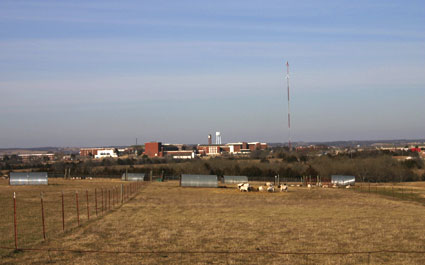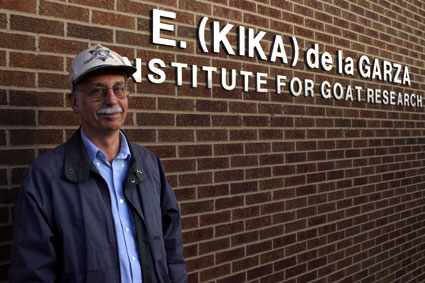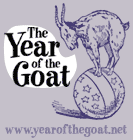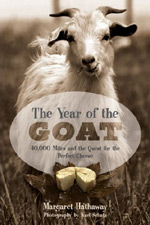 |
| Langston Univeristy, home of the E (Kika) de la Garza American Institute for Goat Research, lies in the distance behind fields of goats in rural Langston, Oklahoma | more photos from Langston |
The E (Kika) de la Garza American Institute for Goat Research is housed, until construction of its new building is complete, in a former dormitory on the campus of Langston University. In this unassuming brick building, down long corridors lined with framed pictures of goats and walled with cracking plaster, doors open onto laboratories filled with sophisticated equipment, dozens of computers, and trolleys packed with labeled samples ready for analysis. Here, using data gathered from the school's herd of 1000 goats of various breeds, some of the most comprehensive and wide-reaching goat research in the country is conducted.
Begun in 1984, the program began as the American Institute for Goat Research, and initially was centered on dairy goats and angoras. The institute was later renamed in tribute to Representative de la Garza, a former legislator from Texas, who served on an agriculture committee in the House, and for the duration of his tenure made sure to include goat research in bills on resource allocation. In the twenty years since its foundation, as the goat industry has grown, the institute has expanded its scope to include cashmere, meat goats, and Tennessee Stiff-leg, or Fainting, goats. Research is performed on many projects, including nutrient requirements for goats, enhanced goat productions systems, composition of tissue gain and loss, sustainable dairy goat milk production from forages, and most recently, the use of goats for sustainable vegetation management. As part of Oklahoma's Extension program, the institute holds an annual goat field day, and throughout the year conducts classes around the region on a variety of goat topics.
On the day we visited, we spoke with Dr. Steve Hart and Dr. Terry Gipson, who gave us a wonderful overview of the program, and told us about its surprisingly international reach. Though Drs. Hart and Gipson are both American, other faculty members come from all over the world; in addition, many foreign scholars have visited, from countries as disparate as Bulgaria, China, and Ethiopia. The faculty travels frequently, as well, to observe and consult on projects. When we were introduced to the institute's director, Dr. Tilahun Salhu, he said that he had just returned from a trip to Ethiopia, where the institute is conducting a long term project that, as quoted from their literature, "aims to enhance family food security and income generating potential through the establishment of women's groups for goat production." The institute has also worked on projects in Armenia, Mexico, China, and Egypt. Before they came to Langston, three faculty members served in the Peace Corps, and though much of the practical application of their research occurs close to home, the research done at the institute is globally minded.
This was especially interesting to us because the university is in such a small, rural town. Langston, Oklahoma, current population 1,670, has historically been an all black town, and the university was founded in the 1890s as a land grant school to serve the African-American community. While visiting, we learned that there are three universities with top flight goat programs that were founded under these same circumstances: Langston in Oklahoma, Fort Valley in Georgia, and Prairie View in Texas. We're curious to see if, at these other schools, the goat programs have developed in such an international direction.
Our visit to Langston reinforced a recurring idea that we've been having about the project. One of the most fascinating aspects of the goat world to us is how interest in one animal — the goat — brings together people from incredibly disparate backgrounds. On a smaller scale, this is true on farms across the country, where goat breeders are brought into contact with members of many ethnic groups, from Middle Eastern to Caribbean, who seek out goat meat from their local suppliers. At Langston, this happens on a large scale, with goat research facilitating a range of cultural exchanges. —MMH



